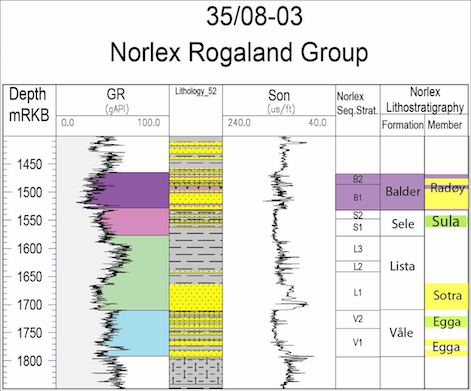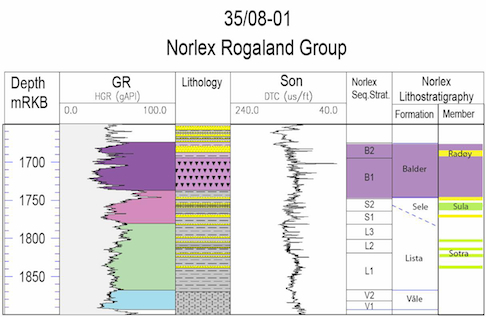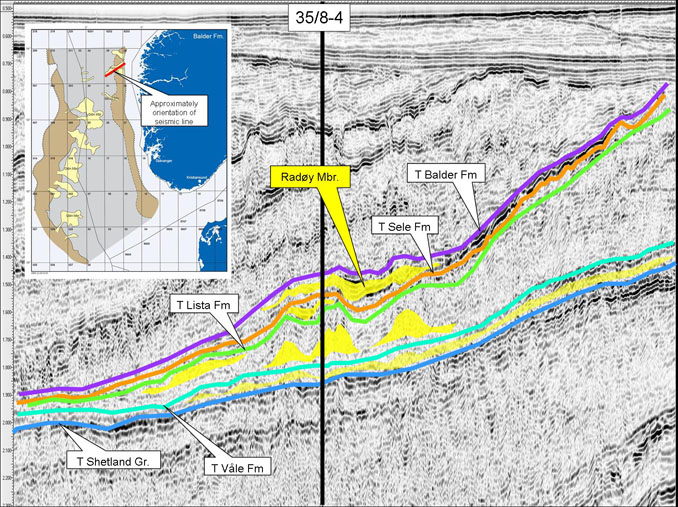Radøy Member (new)
updated to follow: Stratigraphic Guide to the Rogaland Group, Norwegian North Sea. Harald Brunstad, Felix M. Gradstein, Jan Erik Lie, Øyvind Hammer, Dirk Munsterman, Gabi Ogg, and Michelle Hollerbach. Newsletter on Stratigraphy, vol 46/2 pp137-286, 2013.
Rogaland Group, Balder Formation
Unit definition
The Radøy Member is attributed to the Intra Balder Formation sandstones in Subarea NE
(Figs. 1).
 Fig 1: Location map of the Members of the Balder Formation.
Fig 1: Location map of the Members of the Balder Formation. |
Name
The Radøy Member is defined for the first time in this study.
Derivatio nominis
The Radøy Member is named after one of the large islands in Northern Hordaland.
Type well
Norwegian well 35/8-3 (new, Fig. 137)
. Streaks and thin beds of sandstone through depth interval 1418-1525
mRKB. Coordinates N 61°21'05.35", E 03°32'02.63". No cores.

Fig. 137. Well 35/8-3 Composite log Rogaland Group. Stratigraphic position of the
Radøy Member is outlined in stratigraphic column to the right.
|
Reference wells
Norwegian well 35/8-1 (new
, Fig. 138
). Thin beds and streaks of sandstone through depth interval 1675-1685
mRKB. Coordinates N 61°21'26.37", E 03°21'44.09". No cores.
Norwegian well 35/8-4
(new). Depth 1536-1558 mRKB. Coordinates N 61°21'33.03", E 03°30'20.45". No cores.
Norwegian well 35/3-4
(new). Thin beds of sandstones through depth interval 1164-1176 mRKB. Coordinates
N 61°51'54.54", E 03°52'26.99". No cores.

Fig. 138. Well 35/8-1 Composite log Rogaland Group. Stratigraphic position of the
Radøy Member is outlined in stratigraphic column to the right.
|
Composition
The Radøy Member consists of moderately hard to friable clear-white, occasionally
yellow or light green to grey quartzitic sandstones. Grain size is very fine to coarse
grained. Sorting is poor to moderate and grains are subangular to well rounded.
The sandstones are mostly non calcareous and contain traces of mica and glauconite.
There are no cores taken from the Radøy Member, and thus there is limited information
about variability in facies and composition.
Wireline log characterization
The wire line log response for the Radøy Member is blocky to serrated, representing
thick clean sandstones and series of thinner sandstone layers in alternation with
mudstones. Sometimes zones of high velocity sonic readings and high values on density
logs are seen, which seem to correspond to zones of calcite cementation in the
sandstones.
Upper boundary (revised)
The Radøy Member is overlain by the Balder Formation with
variable amounts of tuff.
Since the sandstones often are serrated, and the Balder Formation often contains
calcite cemented stringers, the boundary can often be difficult to pick. The
transition from the Balder Formation is ideally seen as a downwards decrease from
low/intermediate gamma-ray readings to lower gamma-ray readings and an increase in
velocity.
Lower boundary (revised)
The basal contact of the Radøy Member is seen as the boundary between the sandstones
of the Radøy member and the shales of the Sele or Balder
Formation. Due to the often
thin-bedded appearance of the Radøy Member and intercalation with tuffaceous beds and
calcite stringers, the boundary may be difficult to pick.
Ideally the boundary is placed where there is an upwards transition from higher
gamma-ray readings and lower velocity to lower gamma-ray readings and higher velocity.
Thickness
The thickness of the Radøy Member interval consisting of thin beds of sandstones
interbedded with siltstones is 107 m in type well 35/8-3. In reference well 35/8-4 the
Radøy Member is cleaner, and 22 m thick, and in well 35/8-2 there are several
sandstone bodies of 5-10 m thickness.
Although few wells have penetrated a thick, well developed Radøy Member, seismic from
the Sogn Graben area indicate that better developed sandstones of several tens of
meters exist (e.g. well 35/8-4
, Fig. 139
).
Seismic characterization
Sandstones belonging to the Radøy Member sometimes occur within westward dipping
layers in the westwards thinning wedges (prograding slope) of the Rogaland Group at
the Måløy Terrace and the Horda Platform, partly stretching into the Sogn Graben. In
other cases, the presence of blocky log response corresponds to mounded geometries,
especially in lower parts of the wedge. West of the wedge, in what is believed to
represent a basin floor setting, channels and lobe like geometries sometimes stand out
as Balder formation thicks which may be interpreted as potential presence of Radøy
Member sandstones.
Sometimes the top of the Radøy Member is associated with a pronounced change in
acoustic impedance and an increased amplitude
(Fig. 139, right of well)
. In other
cases the top of the Radøy Member is difficult to recognize, and its presence is
inferred from a marked thickening of the Balder Formation interval.

Fig. 139. Seismic line through from Sogn Graben to Måløy Terrace running through
35/8-4. Inferred presence of Radøy Member is outlined.
|
Age
Earliest Eocene (Early Ypresian).
Biostratigraphy
Being contained in the Balder Formation, the age of the Radøy Member is bounded by
biostratigraphy and age assignments for the Balder Formation. See description for the
Balder Formation.
Correlation and subdivision
The Radøy Member is divided into Radøy B1 and Radøy B2, corresponding to
Balder B1 and B2 (see Balder
Formation).
Geographic distribution
The Radøy Member is distributed along the western flank of Sogn Graben and the Måløy
Platform, and is penetrated by several wells in the Quadrants 35 and 31. The
sandstones had their provenance in catchments areas east of the Måløy Terrace and
Horda Platform and possibly the Stord Basin (Fig. 132).
Depositional environment
The Radøy Member was deposited in a distal shelf to prograding slope setting in
eastern areas. Westwards it was deposited by various types of sandy gravity flow
processes in local submarine channels and fans in a slope to basin floor setting.
Discoveries with the Radøy Member as reservoir
No discoveries have been made in the Radøy member so far.


 Fig 1: Location map of the Members of the Balder Formation.
Fig 1: Location map of the Members of the Balder Formation.

